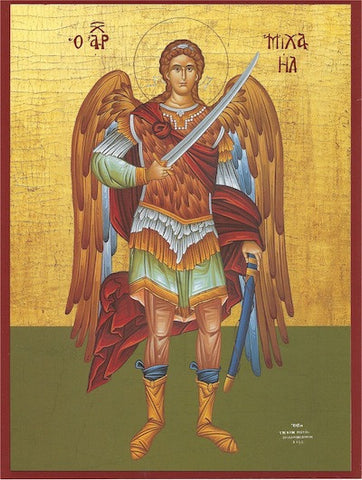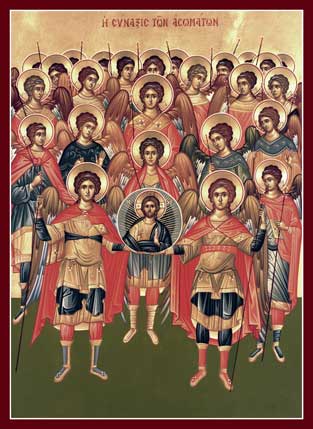Synaxis of the Archangel Michael & the other Bodiless Powers: Gabriel, Raphael, Uriel, Salaphiel, Jegudiel, & Barachiel
Archangel Michael
Over all the Nine Ranks of the Heavenly Powers, the Lord appointed the Holy Archangel Michael (his name in Hebrew means “who is like unto God”), the faithful servitor of God, as Chief Commander. He cast down from Heaven the arrogantly proud Lucifer and the other fallen spirits when they rebelled against God. Michael summoned the ranks of angels and cried out, “Let us attend! Let us stand aright before our Creator and do not consider doing what is displeasing unto God!” According to Church Tradition, and in the church services to the Archangel Michael, he participated in many other Old Testament events.
During the Exodus of the Israelites from Egypt he went before them in the form of a pillar of cloud by day and a pillar of fire by night. Through him the power of the Lord was made manifest, annihilating the Egyptians and Pharaoh who were in pursuit of the Israelites. The Archangel Michael defended Israel in all its misfortunes. He appeared to Joshua Son of Navi and revealed the will of the Lord at the taking of Jericho (Josh 5:13-16). The power of the great Chief Commander of God was manifest in the annihilation of the 185 thousand soldiers of the Assyrian emperor Sennacherib (4/2 Kings 19:35); also in the smiting of the impious leader Heliodorus (2 Macc. 3: 24-26); and in the protection of the Three Holy Youths: Ananias, Azarias and Misail, thrown into the fiery furnace for their refusal to worship an idol (Dan 3:22-25). Through the will of God, the Chief Commander Michael transported the Prophet Habbakuk (December 2) from Judea to Babylon, to give food to Daniel in the lions’ den (Dan. 14:33-37). The Archangel Michael disputed with the devil over the body of the holy Prophet Moses (Jude 1:9). The holy Archangel Michael showed his power when he miraculously saved a young man, cast into the sea by robbers with a stone about his neck on the shores of Mt Athos. This story is found in the Athonite Paterikon, and in the Life of Saint Neophytus of Docheiariou (November 9). From ancient times the Archangel Michael was famed for his miracles in Rus. In the Volokolamsk Paterikon is a narrative of Saint Paphnutius of Borov with an account of Tatar tax-gatherers concerning the miraculous saving of Novgorod the Great: “Therefore Great Novgorod was never taken by the Hagarenes... when... for our sins the godless Hagarene emperor Batu devoured and set the Russian land aflame and came to Novgorod, and God and the Most Holy Theotokos shielded it with an appearance of Michael the Archangel, who forbade him to enter into it. He [Batu] was come to the Lithuanian city and came toward Kiev and saw the stone church, over the doors of which the great Archangel Michael had written and spoken to the prince his allotted fate, ‘By this we have forbidden you entry into Great Novgorod’.” Intercession for Russian cities by the Most Holy Queen of Heaven always involved Her appearances with the Heavenly Hosts, under the leadership of the Archangel Michael. Grateful Rus acclaimed the Most Pure Mother of God and the Archangel Michael in church hymns. Many monasteries, cathedrals, court and merchant churches are dedicated to the Chief Commander Michael. In old Kiev at the time of the accepting of Christianity, a cathedral of the Archangel was built, and a monastery also was named for him. Archangel cathedrals are found at Smolensk, Nizhni Novgorod, Staritsa, at Great Ustiug (beginning of the thirteenth century), and a cathedral at Sviyazhsk. In Rus there was not a city, where there was not a church or chapel dedicated to the Archangel Michael. One of the chief temples of the city of Moscow, the burial church in the Kremlin, is dedicated to him. Numerous and beautiful icons of the Chief Commander of the Heavenly Hosts are also in his Cathedral. One of these, the Icon “Blessed Soldiery,” was painted in the Dormition Cathedral of the Moscow Kremlin. The saintly soldiers, Russian princes, are depicted under the leadership of the Archangel Michael. We invoke Saint Michael for protection from invasion by enemies and from civil war, and for the defeat of adversaries on the field of battle. He conquers all spiritual enemies.On icons the Archangels are depicted in according to the character of their service:
Michael tramples the devil underfoot, and in his left hand holds a green date-tree branch, and in his right hand a spear with a white banner (or sometimes a fiery sword), on which is outlined a scarlet cross.

Source:
https://oca.org/saints/lives/2017/11/08/206396-archangel-michael
Archangel Gabriel
The Archangel Gabriel whose name means “the strength (power) of God,” is the herald and servitor of Divine omnipotence (Dan 8:16, Luke 1:26). He announces the mysteries of God. On icons the Archangels are depicted in according to the character of their service: Gabriel appears with a branch from Paradise, presented by him to the Most Holy Virgin, or with a shining lantern in his right hand and with a mirror made of jasper in his left.
Source:https://oca.org/saints/lives/2017/11/08/103245-archangel-gabriel
Archangel Raphael
The Archangel Raphael, whose name means “the healing of God,” is the curer of human infirmities (Tobit 3:16, 12:15) On icons the Archangels are depicted in according to the character of their service: Raphael holds a vessel with healing medications in his left hand, and with his right hand leads Tobias, carrying a fish for healing (Tobit 5-8).

source:
https://oca.org/saints/lives/2015/11/08/103246-archangel-raphael
Archangel Uriel
The Archangel Uriel, whose name means” the fire or light of God” (2 Ezdras 4:1, 5:20, 10:28). We pray for him to enlighten those with darkened minds. On icons the Archangels are depicted in according to the character of their service: Uriel in his raised right hand holds a naked sword at the level of his chest, and in his lowered left hand “a fiery flame.”
Source:
https://oca.org/saints/lives/2016/11/08/103247-archangel-uriel
Archangel Selaphiel (Salathiel)
The Archangel Selaphiel, whose name means “the prayer of God, impelling to prayer” (3 Ezdras 5:16). He prays to God for mankind. On icons the Archangels are depicted in according to the character of their service: Selaphiel in a prayerful posture, gazing downwards, hands folded on the chest.

Source:
https://oca.org/saints/lives/2017/11/08/103248-archangel-selaphiel-salathiel
Archangel Jehudiel (Jegudiel)
The Archangel Jehudiel, whose name means “one who glorifies God,” encourages us to strive for the glory of the Lord, and intercedes for our efforts to be rewarded. On icons the Archangels are depicted in according to the character of their service: Jehudiel holds a golden crown in his right hand, in his left, a whip of three red (or black) thongs.
Source:
https://oca.org/saints/lives/2017/11/08/103249-archangel-jehudiel-jegudiel
Archangel Barachiel
The Archangel Barachiel, whose name means “the blessing of God,” entreats the mercy of God for people. On icons the Archangels are depicted in according to the character of their service: Barachiel is shown with a white rose on his breast.
Archangel
Which angels?
As it is shown in the Book of the Holy Prophet Ezekiel throughout (compare with the Book of Revelation), the first four archangels (Michael, Gabriel, Raphel, Uriel) are the ones that stand in the four corners of The Great Throne of God (the Ma'aseh Merkabah). Together with them stand the four six-winged Living Creatures (Ayyot), the four many-eyed Cherubim—having four arms, four wings and four faces each—and the four many-eyed Wheels (Ophannim) or Storm-Winds (Galgallim), which Christians, (according to the example of the Great Apostle Paul and that of his illustrious disciple, St. Dionysius the Areopagite) call Thrones. These four archangels are the ones that protected the four camps of the people of Israel in the wilderness: to the North, to the South, to the East and to the West. They are the angels of the four winds, according to the Scripture that says: "[You] Who maketh his angels spirits [literally, winds]; his ministers a flaming fire" (Psalms 104:4, KJV).The ancient rabbis always connected the seven archangels with the seven then known planets: the Sun, the Moon, Mars, Mercury, Jupiter, Venus, and Saturn; and the Church Fathers have always thought and taught that God rules this Universe through his Celestial Armies. There are three (irreducible) lists of these seven archangels. One comes from the Book of Enoch, (which is accepted as canonical by the Ethiopian Orthodox Church, itself representative of the Oriental Orthodox churches). The second is from the tradition of the Chalcedonian Orthodox Church (which, interestingly enough, coincides with that of the Gnostics, an ancient heresy). Finally, the third comes from such great Church Fathers as Sts. Dionysius the Areopagite and Gregory the Theologian. All of these three different lists, however, agree on the names of the first four archangels: Michael, Gabriel, Raphael, Uriel. The remaining three are given as follows:
- From the Book of Enoch (Jewish, as well as Oriental Orthodox tradition): Raguel; Sarakiel or Saraqael; (Je)Re(h)miel or (Je)Ra(h)miel;
- From the Eastern Orthodox tradition: Barachiel; Salathiel; (Je)Gudiel or (Je)hudiel;
- From the Western tradition: (H)anael or (H)aniel; Jophiel or Cassiel; Zedekiel or Sachiel.
Name meanings
- Michael: "Who is like unto God?" Dan. 10:13; 12:1; Jude v. 9; Rev. 12:7-8.
- Gabriel "The Powerful or Strong Man of God," "The Power or Strength of God" Dan. 8:16; 9:21; Luke 1:19-26. Also called Djibril or Jibril.
- Raphael: "The Healing of God" Tobit 3:17; 12:15. Also called Israfel.
- Uriel: "The Light or Fire of God" A.V. II Esdras 4:1. Also called Sariel, Suriel, or Muriel.
- Selaphiel: "The Command, Communicant or Prayer of God", since command and prayer represent the two forms, or types, of communication: the first one being descendant and the second ascendant. Also called Salathiel, Selathiel, Seraphiel, Sarakiel, Saraqael, Zarachiel, Zerachiel, or Zachariel.
- Jehudiel: "The Glory, Laudation or Praise of God." Also called Jegudiel or Gudiel.
- Barachiel: "The Benediction or Blessings of God." Also called Varachiel.
- Raguel: "The Friend of God." Also called Raziel[1], which means "The Secrets of God." Not to be confused with Raphael.
- Jeremiel: "The Compassion, Exaltation or Mercy of God" R.V. II Esdras 4:36. Also called Jeramiel, Jerahmiel, Jerehmiel, Ramiel, or Remiel.
- Anael: "The Grace or Joy of God." Also called Aniel, Hanael, or Haniel.
- Jophiel: "The Beauty of God." Also called Orifiel, Jouphiel, Zouphiel, Zophiel, Zophkiel, Zaphiel, Zaphkiel, Kaphziel, Cassiel, or Kepharel.
- Zadkiel: "The Justice, Righteousness or Uprightness of God." Also called Sachiel, Tzadkiel, Zadakiel, Zedekiel, or Zedekul.
- Lucifer/Satan: "The Light-Bearer" or "The Morning-Star" Isaiah 14:12; "The Enemy" Jude 1:9, Revelation 12:9. Other names for this fallen archangel (or his companions) are: Azael, Azazel, Azrael, Izrael, Izreel, or Uzziel; Camael, Camiel, Camniel, Cancel, Chamuel, Kemuel, Samael, Shemuel, Simiel, or Zamael; Samiaza; Satanael.
https://orthodoxwiki.org/Archangel


No comments:
Post a Comment